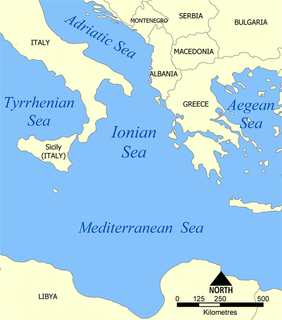
The Ionian Sea is an elongated bay of the Mediterranean Sea. It is connected to the Adriatic Sea to the north, and is bounded by Southern Italy, including Calabria, Sicily, and the Salento peninsula to the west, southern Albania to the north, and the west coast of Greece, including the Peloponnese.
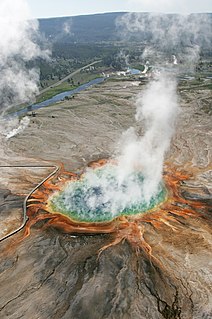
A hot spring is a spring produced by the emergence of geothermally heated groundwater that rises from the Earth's crust. While some of these springs contain water that is a safe temperature for bathing, others are so hot that immersion can result in an injury or death.
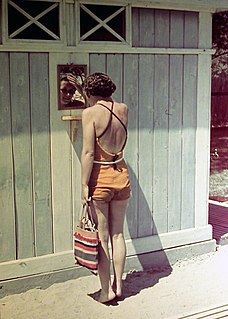
A spa town is a resort town based on a mineral spa. Patrons visit spas to "take the waters" for their purported health benefits. The word spa is derived from the name of Spa, a town in Belgium.

Sorrento is a town overlooking the Bay of Naples in Southern Italy. A popular tourist destination due to its variety of small antique shops and location on the Amalfi Coast, it can be reached easily from Naples and Pompeii as it is at the south-eastern end of the Circumvesuviana rail line. The town is most known for its small shops selling ceramics, lacework and marquetry (woodwork).

Ischia is a volcanic island in the Tyrrhenian Sea. It lies at the northern end of the Gulf of Naples, about 30 kilometres from the city of Naples. It is the largest of the Phlegrean Islands. Roughly trapezoidal in shape, it measures approximately 10 km east to west and 7 km north to south and has about 34 km of coastline and a surface area of 46.3 square kilometres (17.9 sq mi). It is almost entirely mountainous; the highest peak is Mount Epomeo, at 788 metres. The island is very densely populated, with 60,000 residents.

Ponza is the largest island of the Italian Pontine Islands archipelago, located 33 km (21 mi) south of Cape Circeo in the Tyrrhenian Sea. It is also the name of the commune of the island, a part of the province of Latina in the Lazio region.

Procida is one of the Flegrean Islands off the coast of Naples in southern Italy. The island is between Cape Miseno and the island of Ischia. With its tiny satellite island of Vivara, it is a comune of the Metropolitan City of Naples, in the region of Campania.

Pozzuoli is a city and comune of the Metropolitan City of Naples, in the Italian region of Campania. It is the main city of the Phlegrean Peninsula.
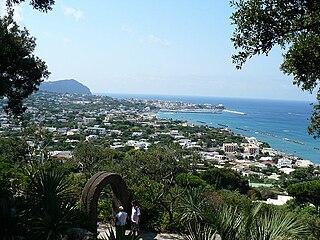
Forio is a town and comune of c. 17,000 inhabitants in the Metropolitan City of Naples, southern Italy, situated on the island of Ischia.

Hvar is a Croatian island in the Adriatic Sea, located off the Dalmatian coast, lying between the islands of Brač, Vis and Korčula. Approximately 68 km (42.25 mi) long, with a high east-west ridge of Mesozoic limestone and dolomite, the island of Hvar is unusual in the area for having a large fertile coastal plain, and fresh water springs. Its hillsides are covered in pine forests, with vineyards, olive groves, fruit orchards and lavender fields in the agricultural areas. The climate is characterized by mild winters, and warm summers with many hours of sunshine. The island has 11,103 residents, making it the 4th most populated of the Croatian islands.

Panarea is the smallest of the seven inhabited Aeolian Islands, a volcanic island chain in north of Sicily, southern Italy. It is a frazione of the comune of Lipari. There are currently about 280 residents living on the island year-round; however the population increases dramatically in summer with the influx of tourists. In recent years, the island has become known internationally for its celebrity visitors.
Citara is a beach located in Forio d'Ischia, in the Ischia island of Italy, near Punta Imperatore and the village of Panza. Its name comes from Romans who consecrated the site to Venus Citarea, whose statue made of white marble was found in the area. An old legend has it that the rocks, which can be seen from the beach, were in origin sailors transformed into stones as a punishment for passing through. The reference is from Odysseus, in which it is told that “Feaci” provided Ulysses with a boat to get home, so the goddess Venus punished them for helping him. On Citara Beach the Poseidon Thermal Garden is provided with a series of sea and thermal water swimming pools. It is known for its sun catching position and limpid sea. Spring water gushes into the sea.
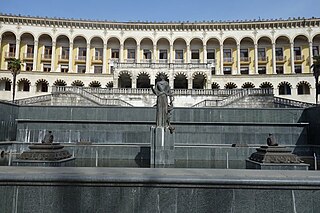
Tskaltubo is a spa resort in west-central Georgia. It is located at around 42°20′23″N42°35′57″E. It is the main town of the Tsqaltubo Municipality of the Imereti province. It is famous for its radon-carbonate mineral springs, whose natural temperature of 33–35 °C (91–95 °F) enables the water to be used without preliminary heating.

Hot Water Beach is a beach on the east coast of the Coromandel Peninsula, New Zealand, just south of Mercury Bay. It is approximately 12 kilometres south east of Whitianga, and approximately 175 kilometres from Auckland by car. Its name comes from underground hot springs that filter up through the sand between the high and low water tidal reaches. The beach is a popular destination both for locals and tourists visiting New Zealand. Annual visitor numbers have been estimated at 700,000, making it one of the most popular geothermal attractions in the Waikato Region.

Kostenets is a town in Sofia Province in southwestern Bulgaria, and the administrative centre of the Kostenets Municipality. The town is situated at the foot of Rila Mountain, about 70 km (43 mi) southeast of capital Sofia.

Saint Restituta is a saint and martyr of the Roman Catholic and Eastern Orthodox Churches.

Suio is a frazione of Castelforte, a municipality in southern Latium, central Italy.

Kaukana, also spelled Caucana, is a southern Italian village and hamlet (frazione) of Santa Croce Camerina, a municipality in the Province of Ragusa, Sicily. It lieas near Kaukanai, an ancient port city from the period of Greek colonisation of Sicily. In 2011 it had a population of 501.
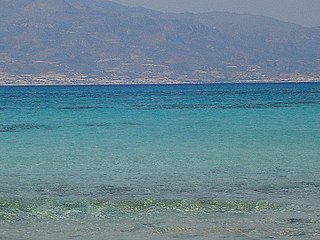
Chrysi or Chrisi, which means "golden", also known as Gaidouronisi, meaning "donkey island" is an uninhabited Greek island approximately 15 kilometres south of Crete close to Ierapetra in the South Cretan Sea. Approximately 700 metres east of the island is the island of Mikronisi. Administratively these islands fall within the Ierapetra municipality in Lasithi.

Jacques Etienne Chevalley de Rivaz was a Swiss-born physician who spent his career in Naples and the Island of Ischia. He was the founder of a famous sanatorium on Ischia and also wrote several works on the geography, archeology, flora and fauna of the island. For his services to Naples during the cholera epidemic of 1836–37, he was awarded a gold medal by King Ferdinand II and citizenship of the Kingdom of the Two Sicilies. Chevalley de Rivaz was born in Vevey, Switzerland and died in Casamicciola, Italy at the age of 62.




















